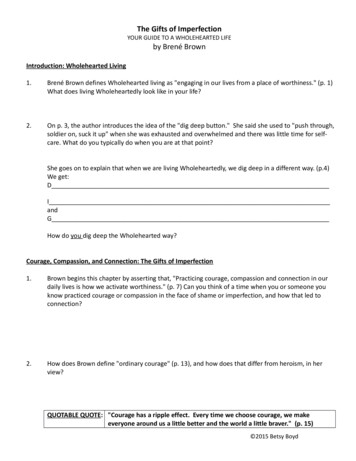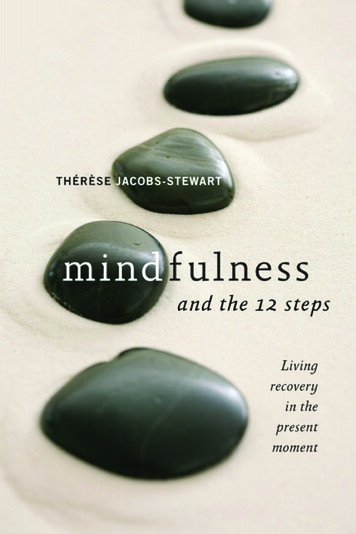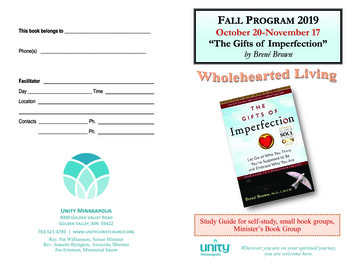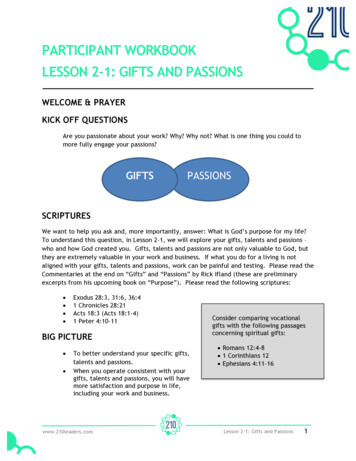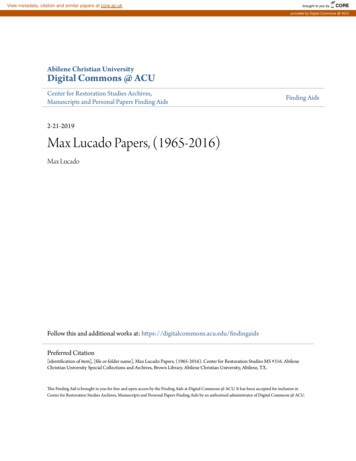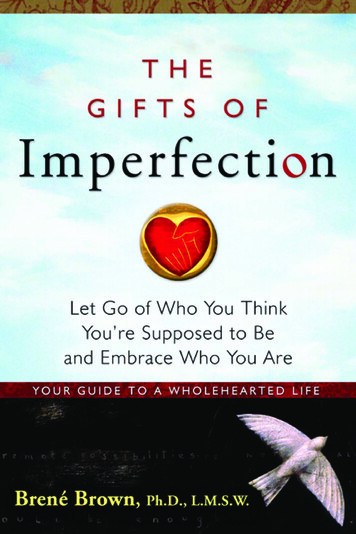
Transcription
The Gifts of Imperfection
Let Go of Who You Think You’re Supposedto Be and Embrace Who You Areby Brené Brown, Ph.D., L.M.S.W.
HazeldenCenter City, Minnesota 55012hazelden.org 2010 by Brené BrownAll rights reserved. Published 2010Printed in the United States of AmericaNo part of this publication may be reproduced, stored in a retrieval system, ortransmitted in any form or by any means—electronic, mechanical, photocopying,recording, scanning, or otherwise—without the express written permission of thepublisher. Failure to comply with these terms may expose you to legal action anddamages for copyright infringement.Library of Congress Cataloging-in-Publication DataBrown, C. BrenéThe gifts of imperfection : let go of who you think you’re supposed to be andembrace who you are / by Brené Brown.p. cm.Includes bibliographical references.ISBN 978-1-59285-849-1 (softcover)1. Self-acceptance. 2. Self-esteem. I. Title.BF575.S37B76 2010158—dc222010016989Editor’s noteThe names, details, and circumstances may have been changed to protect the privacyof those mentioned in this publication.This publication is not intended as a substitute for the advice of health careprofessionals.13 12 11 1012345 6Cover design by David SpohnCover illustrations by Nicholas WiltonInterior design and typesetting by Kinne Design
RTo Steve, Ellen, and Charlie.I love you with my whole heart.
contentsPreface. . . . . . . . . . . . . . . . . . . . . . . . . . . . . . . . . . . . . . . . . . . .Acknowledgments . . . . . . . . . . . . . . . . . . . . . . . . . . . . . . . . . . .Introduction: Wholehearted Living. . . . . . . . . . . . . . . . . . . . . .Courage, Compassion, and Connection:The Gifts of Imperfection . . . . . . . . . . . . . . . . . . . . . . . . . . . . .Exploring the Power of Love, Belonging, andBeing Enough . . . . . . . . . . . . . . . . . . . . . . . .xvii17. . . . . . . . . . . . . . .23. . . . . . . . . . . . . . . . . . . . . . . .31. . . . . . . . . . . . . . . . . . . . . . . . .49. . . . . . . . . . . . . . . . . . . . . . . . . . .55The Things That Get in the WayGuidepost #1 . . . . . . . . . . . . . .Cultivating Authenticity:Letting Go of What People ThinkGuidepost #2 . . . . . . . . . . . .Cultivating Self-Compassion:Letting Go of PerfectionismixGuidepost #3 . . . . . . . . . . . . . . . . . . . .Cultivating a Resilient Spirit:Letting Go of Numbing and Powerlessness. . . . . . . . . . . . . . . . . . .Guidepost #4 . . . . . . . . . . . . . . . . . . . . . .Cultivating Gratitude and Joy:Letting Go of Scarcity and Fear of the Dark vii . . . . . . . . . . . . . . . . .6377
CONTENTSGuidepost #5 . . . . . . . . . . . . . . . . . . . . .Cultivating Intuition and Trusting Faith:Letting Go of the Need for CertaintyGuidepost #6 . . . . . . . . .Cultivating Creativity:Letting Go of Comparison. . . . . . . . . . . . . . . . . .87. . . . . . . . . . . . . . . . . . . . . . . . . . . . . .93Guidepost #7 . . . . . . . . . . . . . . . . . . . . . . . . . .Cultivating Play and Rest:Letting Go of Exhaustion as a Status Symbol andProductivity as Self-WorthGuidepost #8 . . . . . . . . . . . . . . .Cultivating Calm and Stillness:Letting Go of Anxiety as a Lifestyle. . . . . . . . . . . . .99. . . . . . . . . . . . . . . . . . . . . . . .105Guidepost #9 . . . . . . . . . . . . . . . . . . . . . .Cultivating Meaningful Work:Letting Go of Self-Doubt and “Supposed To”. . . . . . . . . . . . . . . . .Guidepost #10 . . . . . . . . . . . . . . . . . . . . . . . . .Cultivating Laughter, Song, and Dance:Letting Go of Being Cool and “Always in Control”Final Thoughts . . . . . . . . . . . . .117. . . . . . . . . . . . . . . . . . . . . . . . . . . . . . . . . . . . .125About the Research Process:For Thrill-Seekers and Methodology JunkiesNotes111. . . . . . . . . . . . . . .127. . . . . . . . . . . . . . . . . . . . . . . . . . . . . . . . . . . . . . . . . . . . .131About the Author . . . . . . . . . . . . . . . . . . . . . . . . . . . . . . . . . . . viii 137
prefaceOwning our story and loving ourselves through that processis the bravest thing that we will ever do.Once you see a pattern, you can’t un-see it. Trust me, I’ve tried. But whenthe same truth keeps repeating itself, it’s hard to pretend that it’s just acoincidence. For example, no matter how hard I try to convince myselfthat I can function on six hours of sleep, anything less than eight hoursleaves me impatient, anxious, and foraging for carbohydrates. It’s a pattern.I also have a terrible procrastination pattern: I always put off writing byreorganizing my entire house and spending way too much time and moneybuying office supplies and organizing systems. Every single time.One reason it’s impossible to un-see trends is that our minds are engineered to seek out patterns and to assign meaning to them. Humans are ameaning-making species. And, for better or worse, my mind is actuallyfine-tuned to do this. I spent years training for it, and now it’s how I makemy living.As a researcher, I observe human behavior so I can identify and namethe subtle connections, relationships, and patterns that help us makemeaning of our thoughts, behaviors, and feelings.I love what I do. Pattern hunting is wonderful work and, in fact,throughout my career, my attempts at un-seeing were strictly reserved formy personal life and those humbling vulnerabilities that I loved to deny.That all changed in November 2006, when the research that fills thesepages smacked me upside the head. For the first time in my career, I wasdesperate to un-see my own research.Up until that point, I had dedicated my career to studying difficultemotions like shame, fear, and vulnerability. I had written academic ix
PREFACEpieces on shame, developed a shame-resilience curriculum for mentalhealth and addictions professionals, and written a book about shameresilience called I Thought It Was Just Me.1In the process of collecting thousands of stories from diverse menand women who lived all over the country—ranging in age from eighteento eighty-seven—I saw new patterns that I wanted to know more about.Yes, we all struggle with shame and the fear of not being enough. And,yes, many of us are afraid to let our true selves be seen and known. Butin this huge mound of data there was also story after story of men andwomen who were living these amazing and inspiring lives.I heard stories about the power of embracing imperfection andvulnerability. I learned about the inextricable connection between joy andgratitude, and how things that I take for granted, like rest and play, areas vital to our health as nutrition and exercise. These research participants trusted themselves, and they talked about authenticity and loveand belonging in a way that was completely new to me.I wanted to look at these stories as a whole, so I grabbed a file and aSharpie and wrote the first word that came to my mind on the tab:Wholehearted. I wasn’t sure what it meant yet, but I knew that thesestories were about people living and loving with their whole hearts.I had a lot of questions about Wholeheartedness. What did these folksvalue? How did they create all of this resilience in their lives? What weretheir main concerns and how did they resolve or address them? Cananyone create a Wholehearted life? What does it take to cultivate whatwe need? What gets in the way?As I started analyzing the stories and looking for re-occurring themes,I realized that the patterns generally fell into one of two columns;for simplicity sake, I first labeled these Do and Don’t. The Do columnwas brimming with words like worthiness, rest, play, trust, faith, intuition, hope, authenticity, love, belonging, joy, gratitude, and creativity.The Don’t column was dripping with words like perfection, numbing,certainty, exhaustion, self-sufficiency, being cool, fitting in, judgment,and scarcity.I gasped the first time I stepped back from the poster paper and took x
PREFACEit all in. It was the worst kind of sticker shock. I remember mumbling,“No. No. No. How can this be?”Even though I wrote the lists, I was shocked to read them. When Icode data, I go into deep researcher mode. My only focus is on accuratelycapturing what I heard in the stories. I don’t think about how I would saysomething, only how the research participants said it. I don’t think aboutwhat an experience would mean to me, only what it meant to the personwho told me about it.I sat in the red chair at my breakfast room table and stared at thesetwo lists for a very long time. My eyes wandered up and down andacross. I remember at one point I was actually sitting there with tears inmy eyes and with my hand across my mouth, like someone had justdelivered bad news.And, in fact, it was bad news. I thought I’d find that Wholeheartedpeople were just like me and doing all of the same things I was doing:working hard, following the rules, doing it until I got it right, alwaystrying to know myself better, raising my kids exactly by the books . . .After studying tough topics like shame for a decade, I truly believedthat I deserved confirmation that I was “living right.”But here’s the tough lesson that I learned that day (and every daysince):How much we know and understand ourselves is criticallyimportant, but there is something that is even more essential toliving a Wholehearted life: loving ourselves.Knowledge is important, but only if we’re being kind and gentle withourselves as we work to discover who we are. Wholeheartedness is asmuch about embracing our tenderness and vulnerability as it is aboutdeveloping knowledge and claiming power.And perhaps the most painful lesson of that day hit me so hard thatit took my breath away: It was clear from the data that we cannot giveour children what we don’t have. Where we are on our journey of livingand loving with our whole hearts is a much stronger indicator of parenting success than anything we can learn from how-to books. xi
PREFACEThis journey is equal parts heart work and head work, and as Isat there on that dreary November day, it was clear to me that I waslacking in my own heart work.I finally stood up, grabbed my marker off the table, drew a line underthe Don’t list, and then wrote the word me under the line. My strugglesseemed to be perfectly characterized by the sum total of the list.I folded my arms tightly across my chest, sunk deep down intomy chair, and thought, This is just great. I’m living straight down theshit list.I walked around the house for about twenty minutes trying to un-seeand undo everything that had just unfolded, but I couldn’t make thewords go away. I couldn’t go back, so I did the next best thing: I foldedall of the poster sheets into neat squares and tucked then into aRubbermaid tub that fit nicely under my bed, next to my Christmaswrap. I wouldn’t open that tub again until March of 2008.Next, I got myself a really good therapist and began a year of serious soul work that would forever change my life. Diana, my therapist,and I still laugh about my first visit. Diana, who is a therapist to manytherapists, started with the requisite, “So what’s going on?” I pulled outthe Do list and matter-of-factly said, “I need more of the things on thislist. Some specific tips and tools would be helpful. Nothing deep. Nochildhood crap or anything.”It was a long year. I lovingly refer to it on my blog as the 2007Breakdown Spiritual Awakening. It felt like a textbook breakdown tome, but Diana called it a spiritual awakening. I think we were both right.In fact, I’m starting to question if you can have one without the other.Of course, it’s not a coincidence that this unraveling happened inNovember 2006. The stars were perfectly aligned for a breakdown: I wasraw from being newly sugar and flour free, I was days away from mybirthday (always a contemplative time for me), I was burned out fromwork, and I was right on the cusp of my midlife unraveling.People may call what happens at midlife “a crisis,” but it’s not. It’san unraveling—a time when you feel a desperate pull to live the life youwant to live, not the one you’re “supposed” to live. The unraveling is a xii
PREFACEtime when you are challenged by the universe to let go of who you thinkyou are supposed to be and to embrace who you are.Midlife is certainly one of the great unraveling journeys, but thereare others that happen to us over the course of our lives: marriage divorce becoming a parent recovery moving an empty nest retiring experiencing loss or trauma working in a soul-sucking jobThe universe is not short on wake-up calls. We’re just quick to hit thesnooze button.As it turned out, the work I had to do was messy and deep. I sloggedthrough it until one day, exhausted and with mud still wet and drippingoff of my traveling shoes, I realized, “Oh, my God. I feel different. I feeljoyful and real. I’m still afraid, but I also feel really brave. Somethinghas changed—I can feel it in my bones.”I was healthier, more joyful, and more grateful than I had ever felt. Ifelt calmer and grounded, and significantly less anxious. I had rekindledmy creative life, reconnected with my family and friends in a new way,and most important, felt truly comfortable in my own skin for the firsttime in my life.I learned how to worry more about how I felt and less about “whatpeople might think.” I was setting new boundaries and began to let go ofmy need to please, perform, and perfect. I started saying no rather thansure (and being resentful and pissed off later). I began to say “Oh, hellyes!” rather than “Sounds fun, but I have lots of work to do” or “I’ll dothat when I’m (thinner, less busy, better prepared).”As I worked through my own Wholehearted journey with Diana, I xiii
PREFACEread close to forty books, including every spiritual awakening memoirI could get my hands on. They were incredibly helpful guides, but I stillcraved a guidebook that could offer inspiration, resources, and basicallyserve as a soul traveler’s companion of sorts
The gifts of imperfection : let go of who you think you’re supposed to be and embrace who you are / by Brené Brown. p. cm. Includes bibliographical references. ISBN 978-1-59285-849-1 (softcover) 1. Self-acceptance. 2. Self-esteem. I. Title. BF575.S37B76 2010 158—dc22 2010016989 Editor’s note The names, details, and circumstances may have been changed to protect the privacy of those .
